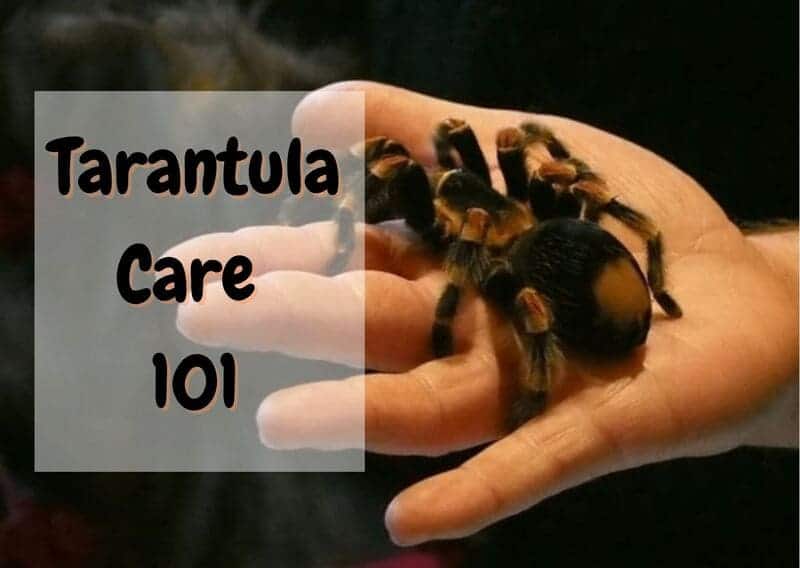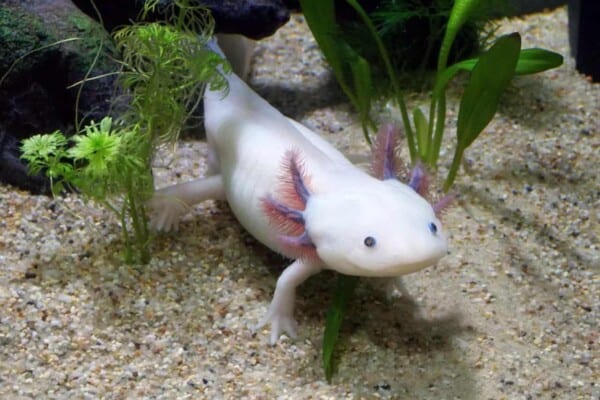Learning how to care for a tarantula is important for the well-being of your critter, and there is definitely a right way of caring for a pet tarantula. So if you want to know the basic rules of tarantula care, keep reading.
Listed below is the need-to-know of caring for a pet tarantula. These are general guidelines since each species has its own requirement, so feel free to refer to the specific care sheet of the species you are thinking of getting.
1. Set Up The Right Habitat For Your Tarantula
The very first step to caring well for your tarantula is by creating the right habitat. The type of habitat you’ll set up depends on whether you have a terrestrial or arboreal species. Terrestrial tarantulas live on the ground whereas arboreal tarantulas live above ground.
If you’re going with a terrestrial tarantula, you’ll need a horizontal terrarium. If you’re going with an arboreal tarantula, you’ll need a vertical terrarium. This article will guide you through the steps to set up your tarantula enclosure.
When it comes to size, you don’t want to get a terrarium that is too large or too small. A large tank may make it difficult for your pet spider to attack its prey whereas a small tank interferes with its molting process. For a terrestrial tarantula, the floor needs to be 3x as wide and long as its leg span and the same goes for an arboreal tarantula, but in the vertical direction.
We have covered in this article the best enclosures both for terrestrial and arboreal tarantulas currently on the market.
2. Use Good Quality Substrate Only
Proper tarantula care means a careful choice of substrate. In a way, the substrate is to the tarantula what a bed is to a human – quite an essential part of its habitat and something the tarantula will spend most of its time on. Here are some popular and common substrate options to place in the terrarium, and some pros and cons of using each of these.
1. Coco Fiber
- Relatively inexpensive
- It absorbs water well, which is a good thing for tarantula species that require some moisture
- Mold resistant.
- It can be time-consuming to rehydrate the bricks regularly
- It becomes fluffy when dry, which makes it difficult for species that like to burrow
- Coco fiber dries out quickly
We recommend: Critters Comfort Insect & Arachnid Habitat Substrate Natural Coconut Fiber
2. Topsoil
- Inexpensive
- It combines well with other substrates
- One of the best substrates for burrowing tarantula species
- The quality is sometimes inconsistent (jagged chunks of wood chips and branches)
- Topsoil is very heavy to use for large enclosures and needs to dry before using it in an arid enclosure
- Sometimes creates puddles or mud when sprayed and moistened
3. Peat Moss
- Inexpensive
- Very good for burrowing spider species
- It absorbs water well, making it a good choice for species that require moisture
- Peat moss combines well with other substrates.
- If used dry, it becomes a little dusty and is prone to mold growth
Recommended: John’s frog Dig-It
4. Vermiculite
- Good for species requiring moisture as it retains water better than peat moss and coco fiber
- Vermiculite is good for spiders requiring more humidity as the water evaporates slowly
- It combines well with other substrates
- Adding too much can make the soil fluffy
5. Sphagnum Moss
- Good for species that require increased humidity levels since it absorbs water well
- Using it alone will not allow some spider species to burrow easily
Recommended: Zoo Med New Zealand Sphagnum Moss
Dos and don’ts of Buying Substrate
Choosing the right substrate can be a daunting task, but the 5 substrates mentioned above are known to enhance the habitat of your tarantula. You can also choose to make your own. Whatever the case may be, here are a few extra tips on the use of substrate:
- Do filter out any jagged sticks and pieces from the substrate, as they can cause harm to your spider. Falling on a sharp edge can rupture the abdomen.
- Do not buy substrates with additives or fertilizers, but only organic substrates.
- Do not use aquarium gravel, as it tends to puddle and pool below the surface, causing your pet tarantula’s leg to get trapped.
- Do not use corn cob granules as they are prone to mold growth, requiring you to remove and replace them regularly.
- Do not use sand, as it is heavy and does not absorb water well.
You can place a water bowl, but be sure to replace the water daily. You can also add other decorations, such as cork bark, bark rounds, or coconut shell inside the terrarium. It is best to use only material that will not bring bacteria or parasites. Plastic and ceramic are good choices.
3. Clean the terrarium regularly
Ideally, you should clean and disinfect the terrarium at least once per month. Remove your tarantula from its terrarium and place it in a secure habitat so that it can’t escape.
Next, you need to use a 3% bleach cleaner to scrub the terrarium and furnishings before you fill it with a new substrate.
4. Keep temperature and humidity at optimal levels
Temperature and humidity are two very important for your tarantula. These will depend on your type of tarantula since you will want to mimic as much as possible its natural environment in the wild. To do so, please refer to your species’ care sheet.
Most tarantula species require a temperature between the high 60s and mid-80s degrees Fahrenheit. In winter, if the temperature of your home remains between 67 to 70 degrees Fahrenheit, you don’t need to invest in a heat source.
If you must buy a heat source, avoid heat pads, heat lamps, heat mats, and heat rocks as they can injure, dehydrate, and kill your pet tarantula. Use a space heater instead.
In terms of humidity, keep in mind that different tarantula species have different temperature and humidity requirements. Arboreal tarantulas generally prefer a more humid environment since they live in the rainforest, in which case the humidity level should be around 80-90%. Terrestrial desert tarantulas will be happy with a humidity level of around 40-50%.
5. Watch your tarantula’s diet
Like for any other pet, a healthy diet is essential to make sure your tarantula stays healthy. A well-balanced tarantula diet includes live insects, such as gut-loaded crickets, cockroaches, superworms, locusts, and mealworms.
Some tarantula species may eat pre-killed pinkie mice at room temperature. However, it should not be part of their everyday diet, just reserved as a special treat to be given occasionally. You need to feed juvenile tarantulas each day whereas adult tarantulas generally eat twice or three times a week.
A general rule to follow is to feed your tarantula 3 to 6 crickets each week. However, some tarantulas eat less than that. You should feed them at night, as they are nocturnal.
You should clean out their terrarium every day, removing any leftover live food as it may injure your tarantula. Lastly, you should give your tarantulas clean, fresh, and chlorine-free water.
6. Take extra care during the molting period
How do you take care of a tarantula during the molting process? The molting involves tarantulas shedding their old skin for a new one. They molt to grow in size. A tarantula will pop the top of its exoskeleton called the carapace and then take the body and legs out of the old skin.
In most cases, a tarantula lies on its back or side during the molting process. One sign that your tarantula is ready to molt is when they stop eating. A young tarantula will not eat for a few days whereas a fully-grown tarantula will not eat for weeks.
You should not disturb your tarantula during the molting process, as it may cause them to die. Once they have shed their old skin, it is important that you do not handle your tarantula or feed them anything until their new skin hardens, as it is soft at the beginning. You can feed your spider after two weeks.
7. Monitor your tarantula’s health constantly
Your tarantula is healthy if it’s eating food regularly (except during the pre-molt stage), has healthy skin, and is active and alert.
You should be worried if you notice the following signs: dull skin, injury to the abdomen or leg, very slow movements, and a loss of appetite not related to molting. A dehydrated tarantula will have a shriveled appearance and move slowly.
If your tarantula gets stuck in its molt, you will need to wet them with water, and even if that does not work, you should take it to the veterinarian.
8. Learn how to handle your tarantula properly
Some tarantula species are more docile and easy to handle than others. The three ways to handle a tarantula include the cupping method, the free-hand method, and the pinching method. It is important to handle your tarantula at a height that will not be dangerous if it falls – either sitting on the floor, inside a bathtub, or above a table.
Tarantula bites
Most species are non-aggressive and would only bite if threatened or poorly handled. Even so, a tarantula bite has been described by tarantula handlers as no more painful than a bee sting and results in localized swelling and pain. Besides, no one has died from a spider bite.
However, everyone reacts differently to a tarantula bite, so if you have some known allergies to other bug stings, it may be best to have it checked by a practitioner.
Another thing you need to watch out for is your pet tarantula flicking its urticating hairs towards its target if they feel or sense a threat, so you should always keep them away from your eyes. If your spider flicks its hairs on your arms or legs, it can cause a mild reaction such as a rash.
Tarantulas very rarely bite, but before they do, they will send you ample warning so you can back away and keep your hands to yourself.
Conclusion – How to Care For a Tarantula
Caring for a pet tarantula is no rocket science as these creatures are generally docile, and quiet and they like to mind their own business. Your ever-growing experience of caring for your spider can definitely make for a happy pet and an even happier owner.
Where can you buy a tarantula? You can purchase them at several pet stores in your area. You may also get one from some online pet stores, which will happily ship the critter to you in a box, ready to be unboxed a few hours later.
Since you’re a first-time tarantula owner, you should go with species that are good for beginners. Once you have experience with taking care of spiders, you can buy other types of exotic tarantula species.
Contents
- 1. Set Up The Right Habitat For Your Tarantula
- 2. Use Good Quality Substrate Only
- 3. Clean the terrarium regularly
- 4. Keep temperature and humidity at optimal levels
- 5. Watch your tarantula’s diet
- 6. Take extra care during the molting period
- 7. Monitor your tarantula’s health constantly
- 8. Learn how to handle your tarantula properly
- Conclusion – How to Care For a Tarantula













